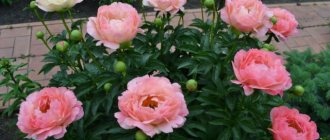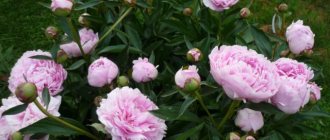Preparing for winter
Pre-winter pruning of the stems of ITO hybrids is carried out after the plants begin to wither, but before the onset of constant cold rainy days.
After pruning, stumps 2-3 cm high should remain on the soil surface. Winter-hardy ITO hybrids can suffer from frost in a snowless winter, so you need to make a decision about insulating peony bushes based on actual weather conditions. As mulch, agrofibre folded in several layers, spruce spruce branches, rotted sawdust, and a mixture of sand and peat are used.
People who grow Itoh Canary Brilliants hybrid peonies can be considered truly lucky. Indeed, in their gardens, in the flower beds in early spring, luxurious flowers bloom, the sight of which evokes delight and admiration.
The climate in the Moscow region is complex, unstable, spring is late, autumn is short, in summer there is a sharp change in temperature, and it often rains. In winter, severe frosts are constantly replaced by thaws. In such conditions, only the most unpretentious plants survive. Peonies cannot be called too capricious, however, not all varieties take root in the Moscow region.
Peonies are divided into 3 subspecies - herbaceous, tree-like and artificially bred ito-hybrids. There are a little more than 40 species of flowers, and the number of their varieties can no longer be counted; they appear every year. Varieties that are frost-resistant, with strong immunity to high humidity, diseases, pests and frequent weather changes are suitable for growing in the Moscow region; we will highlight the best of them with photos and descriptions.
Diseases, pests, ways to combat them
Among the diseases that affect peonies are powdery mildew and gray rot. If signs of disease occur, it is recommended to treat the bushes with copper sulfate. A soap solution is well suited for the same purpose.
Among the pests you should be wary of are turf ants and root-knot nematodes. Sometimes the bushes are attacked by the bronze beetle. Chemicals help deal with them. Among them are Kinmiks and Aktara.
Having studied the description and features of such a flower as Diamonds, we can come to the following conclusion. Despite its demands on humidity and temperature conditions, this variety remains in demand due to its unusual colors and large amount of greenery.
Description of Paeonia Itoh Canary Brilliants
The Canary Brilliants peony is part of a group of elite, prestigious plants from the genus Paeonia, famous for the unique colors of its petals. The hybrid was created in 1999 by the American hybridizer R. Anderson. In 2010, Itoh Canary Brilliants was awarded the American Peony Society's Award of Landscape Merit.
Each stem of the Itoh Canary Brilliants peony bears up to 4 buds. In light partial shade, semi-double inflorescences of the Canary Diamond peony change their color during the flowering period from pinkish, soft peach to yellow shades. The bases of the petals, wavy along the edges, are colored reddish.
Note! In an open, evenly sunny growing area, the Kenery Diamond peony will be completely colored in bright peach or yellow shades. The bush blooms for about 3 weeks.
Flowers have stamens and pistils, but no pollen, so once the flower fades, no seeds are produced. In a bouquet placed in a vase with water, cut peony branches do not lose the petals of the inflorescences for 10 days. Flowers smell nice
The bush blooms for about 3 weeks. Flowers have stamens and pistils, but no pollen, so once the flower fades, no seeds are produced. In a bouquet placed in a vase with water, cut peony branches do not lose the petals of the inflorescences for 10 days. The flowers smell nice.
The bushes have a spreading, raised shape, dense branching, dense foliage, and strong peduncles. The plant as a whole looks lush and massive. The stems of the flower, up to 80 cm high, do not bend to the ground even during the period of mass bud opening.
The size and appearance of the leaf blades of the Kenery Brillint peony received from a tree-like ancestor. During the growing season and flowering, the leaves are colored a rich dark green; in August their color changes and becomes bronze-burgundy.
Note! The already faded peony ITO Canary Diamonds does not lose its decorative effect until the first frost. It is widely used to create multi-tiered mixborders, in rock gardens, linear and group landscape compositions, for single cultivation
Opened flower and bud of peony ITO-hybrid Canary Diamond
History of creation
Among the herbaceous peonies there were always many beautiful flowers, but there were no plants with gold-colored petals, but some shrubs bloomed with yellow inflorescences. The desire of the Japanese scientist Toichi Itoh to have a sunny-colored flower in his garden led him to begin crossing herbaceous and tree-like peonies. But only after the death of the breeder were hybrids with yellow inflorescences produced. In 1974 they were registered by the American Peony Society.
Tree peony bushes
Numerous varieties of hybrids obtained by interspecific crossing began to be given the name Ito-peonies. They are characterized by inheritance with simultaneous improvement of characteristics inherent in both parents:
- abundant and long flowering;
- powerful herbaceous stems that do not require garter;
- inflorescences up to 20 cm in diameter;
- increased frost resistance and drought resistance.
For your information! The above-ground part of ITO hybrids dies off for the winter, like herbaceous plants.
Ito-peony Canary Diamond
Landing
It is better to plant peonies in August or September. Peonies "Canary Diamonds" are undemanding to the soil, and they are quite happy with clean loamy soil with neutral acidity. But the close location of groundwater is completely undesirable for them. In these circumstances, an artificial embankment drainage layer will be required. In this case, the landing site should be illuminated by the sun or be slightly shaded.
Ito-peonies are propagated mainly by divisions, each of which should have from two to five healthy buds and roots.
Care must be taken to ensure that peonies have enough space to grow. A distance of a few meters from the nearest neighbors in the garden would be ideal.
To plant Canary Diamonds ito-peonies, prepare holes measuring 70x70x70 cm. The peonies themselves should be planted at a distance of 1-1.5 meters from each other. The lowest layer is filled with drainage from small pieces of brick, pebbles or expanded clay to about 15 cm. The next layer is filled with compost and mineral fertilizers.
Drainage and compost pits are left alone for a week. During this time, they will settle, and you can start planting. To do this, the root of the bush is placed in a hole, covered with earth and compacted. Vegetative buds must be left at a level of at least 5 cm.
Peonies cannot be buried; deeply planted ones do not bloom.
Peonies begin to be watered with the onset of spring. The soil should be moistened, but moisture should not stagnate. About two or three buckets of water should be poured under a mature Canary Diamonds peony bush. If the ground around the peonies is not mulched, then weeding and loosening are mandatory. Mulching is covering the soil with various materials to reduce moisture loss and prevent soil cracking, and straw works well as the simplest mulch.
Peonies should be fed in three stages: as soon as the snow melts, 10 grams of potassium and nitrogen are scattered around the bush, then watered; during the period of bud growth, 10 grams of nitrogen, 12 grams of potassium, and 15 grams of phosphorus are also scattered; Fertilizers are applied for the third time two weeks after flowering. To do this, add 12 grams of potassium and 20 grams of phosphorus under each bush.
It is not recommended to apply nitrogen fertilizers during flowering, since in this case the plants will spend all their energy on developing leaves and stems.
To deoxidize the soil, it is recommended to use dolomite flour and ash. They can be added to the soil at any time of the year, but the preferred period for their application is spring or autumn. Dolomite flour is applied to the soil once every three years. Ash has less pronounced deoxidizing properties, so it can be added more often.
Peony care First Arrival
In order for the peony of the Ito First Arrival variety to feel good in the bed allocated to it, proper care is necessary:
- mulching immediately after planting and in cold weather (sawdust and hay are suitable);
- regular loosening and weeding of the soil, eliminating large weeds and preserving the flower circle;
- periodic feeding;
- regular watering at the roots.
The soil under the plant should not be allowed to dry out completely; each bush consumes up to 20 liters of water at a temperature of +20 ℃. After watering, it is necessary to loosen the soil to avoid crust formation.
Feeding schedule:
- in April, nitrogen and potassium are added for active growth;
- when the buds bloom, add complex fertilizer;
- Phosphorus and potassium are added towards the end of the season at the end of August.
To prevent the appearance of rust, rot and aphids in April (early and late May), it is necessary to treat the soil with a fungicide.
Varieties of pink peonies growing in the Moscow region
Very popular among gardeners are varieties with flowers painted in different shades of pink, symbolizing tenderness, love, purity and meekness. Petals can be from delicate pastel colors to almost black magenta.
There are most of these varieties, we have already noted several of them above, now we will highlight the most beautiful and luxuriantly blooming ones:
- Madame Butterfly. Belongs to the Japanese group of herbaceous, terry peonies. The lower, wide petals are pink-lilac, and the inner, narrow petals are crimson. The diameter of the inflorescence is about 18–20 cm.
- Hilary. A miniature ito-hybrid, the bushes rarely grow above 70 cm. The flowers are up to 17 cm in diameter, semi-double, pink at first, gradually acquiring a creamy hue. There is a distinct red spot at the bottom of the petals.
- Sarah Bernhardt. An ancient, herbaceous, double variety that blooms in mid-June. Each bush opens with 4–5 pink flowers, the first 15–20 cm in diameter, the rest no larger than 12 cm.
- Bouquet of pink carnations. The shape of a tree peony with crown-shaped, fluffy, very delicate flowers, 18 cm in diameter. Bush up to 1.5, blooms profusely from the end of May.
- Typhoon. A herbaceous variety with pink, double flowers (16–19 cm across). The petals are dark crimson in color; in good sunlight, a light chocolate tint is noticeable. Bushes up to 75 cm.
A few more unpretentious pink peonies that are resistant to cold and high humidity: Albert Kruss, Dresden Pink, Jubilee, Coral Pink, Madame Boulanger, Premiere, Skarbnitsa, Svetlana Udintseva, Monsieur Jules Ely, James Pillow, Mrs. F. D. Roosevelt, Top Brass . Less popular, but also noteworthy varieties: Princess Margaret, Pink Raidians, Polonaise, Dinner Plate, Rose Marie Line, Lady Kate.
Planting and care
Typically, peonies begin to be planted in late summer or early autumn (permissible in April). Choosing a place is quite simple - it should be open, well lit, without drafts. The soil should be light. Since peonies do not like stagnant moisture, it is preferable to choose a small hill rather than a lowland. If possible, bushes can be planted near a house or fence to protect them from strong wind gusts.
Before planting the Canary Diamonds peony, you need to prepare in advance a fertile mixture of compost and garden soil (2:1). It is useful to add 200 g of superphosphate fertilizer and 60 g of potassium salt to them. The algorithm is as follows:
- First, the area is cleared and dug up to 25-30 cm.
- Create several holes with a minimum interval of 70-80 cm.
- Lay a layer of drainage (pebbles, expanded clay, broken brick).
- Add a fertile mixture and root the seedling.
- Water generously and mulch with pine needles, hay, straw and other available materials.
Application in design
Peonies fit well into the space of any flower garden, since they decorate not only with their flowers, but also with beautiful, lush bushes. Canary diamonds are often planted in the most visible place, for example, next to a gazebo, near a porch, or in the center of a flower garden. It is advisable to do single plantings in a well-groomed area - a trimmed lawn is ideal for this.
Since the bushes of this peony are relatively tall, it can be planted as a “wall” along the paths, focusing on an interval of 80-100 cm. Along with single plantings, Canary Diamonds also looks good in flower arrangements:
- flower beds and flower beds;
- mixborders;
- rock gardens;
- next to the recreation areas there is a terrace, a pond and others. Canary diamonds look advantageous against the backdrop of creeping, low-growing plants
Peonies are combined with a wide variety of flowers and ornamental crops. The following can grow in the same flowerbed with them: irises, hydrangeas, tulips, daffodils, daylilies, roses, ground covers, dwarf conifers (especially beautiful in rock gardens).
When choosing the right composition, it is important to consider color and size. Since Canary Diamonds bushes are large, they are most often planted in the background, and then several tiers are formed from other plants
All kinds of plants can be planted next to peonies, except for large shrubs and trees, since the latter create a noticeable shadow that prevents the flower from developing normally. It is also undesirable to be in the vicinity of Buttercups, which quickly take over space and take away water and nutrients from the main crop.
Plant care
In order for an ornamental plant to delight with its bright greenery and abundant flowering, no special care is required. It is enough to maintain soil moisture, periodically fertilize the bushes and, if necessary, treat them against pests.
Watering and fertilizing
Watering the bushes begins in early spring. Each bush requires 2-3 buckets of water, which is applied to the root zone. The frequency of watering may vary and depends on the climatic characteristics of the region.
Note! The soil should always remain slightly moist, but waterlogging will cause the rhizomes to rot. It is recommended to fertilize the Ito Canary Diamonds peony 3 times per season:
It is recommended to fertilize the Ito Canary Diamonds peony 3 times per season:
- After the snow melts, nitrogen and potassium (10 g each) are scattered near each bush. After this, water the root zone.
- During the formation of buds. To the already mentioned components add 15 g of phosphorus.
- After the end of the flowering period (after 12-14 days), each bush is fed with potassium (12 g) and phosphorus (20 g).
To prevent the top layer of soil from drying out, the ground around the flowers is mulched. This term refers to sprinkling the soil with one material or another. This is done to reduce moisture loss and prevent cracking of the soil. For peonies, the easiest way is to sprinkle the ground with straw or peat.
To prevent bushes from becoming infected with fungal diseases, experienced gardeners recommend treating them with the biofungicide Fitosporin or a soap solution. It is better to carry out such procedures before the first signs of infection appear.
Peonies after flowering
After the flowering period has passed, the plant is fertilized. Despite the lack of buds, the bushes do not lose their attractiveness due to the large number of leaves.
Transfer
Transplantation for the purpose of propagation is recommended to be carried out in the fall after the flowering period or in early spring. If the latter option is chosen, then you can divide the bush until it has red shoots reaching a height of 15-20 cm.
If the bush needs to be transplanted to another place without dividing, this can be done in the summer.
Trimming
Experienced flower growers recommend periodically cutting off buds that have already bloomed. This stimulates further flowering.
Preparing for winter
In late autumn, the flower stems are cut off, leaving columns no higher than 3-5 cm. In areas with cold winters, the Ito hybrid Canary Diamond peony is covered with spruce branches or sawdust.
Additional Information! Plants should not be covered with film for the winter. Due to the greenhouse effect, the rhizomes and above-ground parts rot.
ITO-peony Julia Rose (Julia Rose)
Medium flowering variety. American selection, originator – Andersen, 1991.
One of the most popular varieties of ITO peonies in the chameleon category.
Herbaceous perennial, loves sunny places. Frost resistance zones 4-8. The height of the bush is 70-80 cm, the plant has strong shoots and grows quite slowly. The leaves are large, dark green, glossy.
The flowers are semi-double and double, about 18 cm in diameter, cherry-red in color, later fading unevenly to pink, peach and pale yellow with a cherry spot in the center. The petals are very thin. Flowers bloom one by one. The aroma is very light. Flowering duration is 0.5-1 month.
The flowers stand well as cut flowers. Peony is very resistant to pests and diseases.
Growing a flower, how to plant it correctly in open ground
The health of the plant, its growth and flowering largely depend on proper preparation and planting.
For this reason, you should pay attention to the preparation of the soil and planting material
The easiest way to plant these flowers is to divide the bush. In order for the plant to grow quickly, you need to choose the right mother bush.
In this case, it is important to comply with a number of conditions:
- The donor plant should not be too young. The best age for breeding is 3-4 years. At this time, a large number of buds already appear on the bushes.
- The rhizome of the flower should be well developed.
Note! A small part of it (about 10-15 cm in size) is separated from the common rhizome. There are 2-5 buds on this division
Dividing the mother bush and planting the division is best done in the fall. August and the first half of September are good. Overwintered peonies will actively begin to grow in early spring.
Peony Canary Brilliants takes root well in loamy soil, the acidity of which is close to neutral. Flowering activity directly depends on the degree of illumination, so it is better to choose a site in the sun or light partial shade.
Important information! To ensure that the bushes can grow freely, peonies should not be planted close to other trees and shrubs.
First of all, a pit with dimensions of 70×70×70 cm is organized. The distance between peony bushes should be at least 0.7-1 m. Several layers are laid at the bottom of the pit:
drainage, because excess moisture has a bad effect on the growth and appearance of flowers, so it is important to provide a drainage layer of 15 cm; compost and fertilizers, which use mineral compounds.
When landing, the following types of work are performed:
The rhizome with buds is placed in a pre-prepared hole. Carefully fill the hole with earth. In this case, you need to ensure that the buds are no deeper than 5 cm from the surface of the earth. The earth is compacted and left to overwinter.
Peony propagation by rhizome
Planting by seeds
Summer residents and flower growers practically do not use this method of planting. Dividing the rhizome allows you to solve the problem of reproduction as efficiently as possible with minimal effort.











